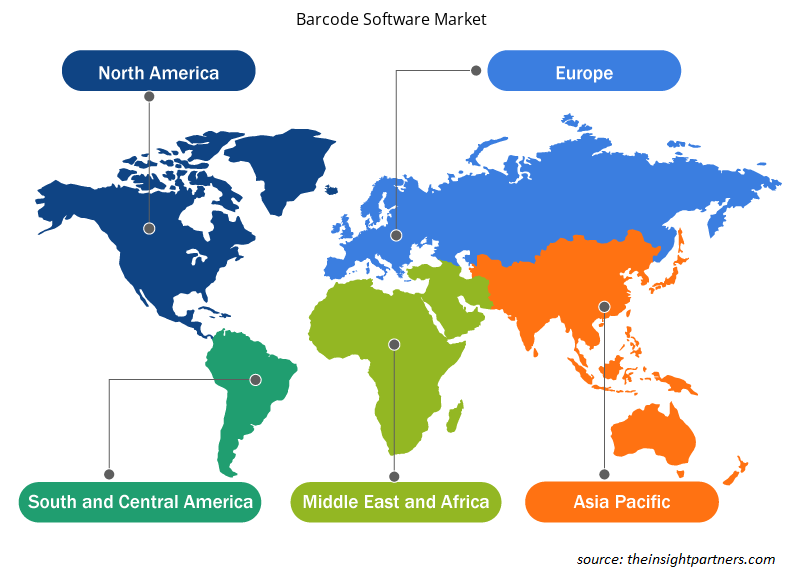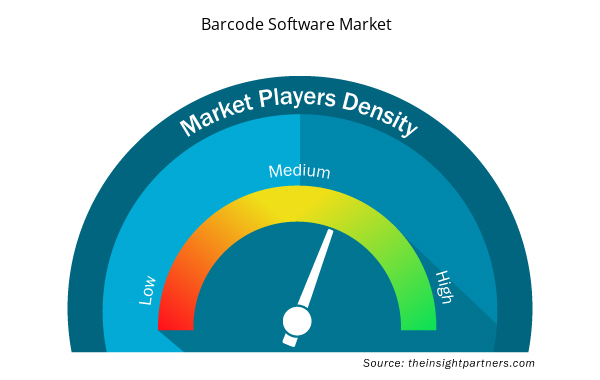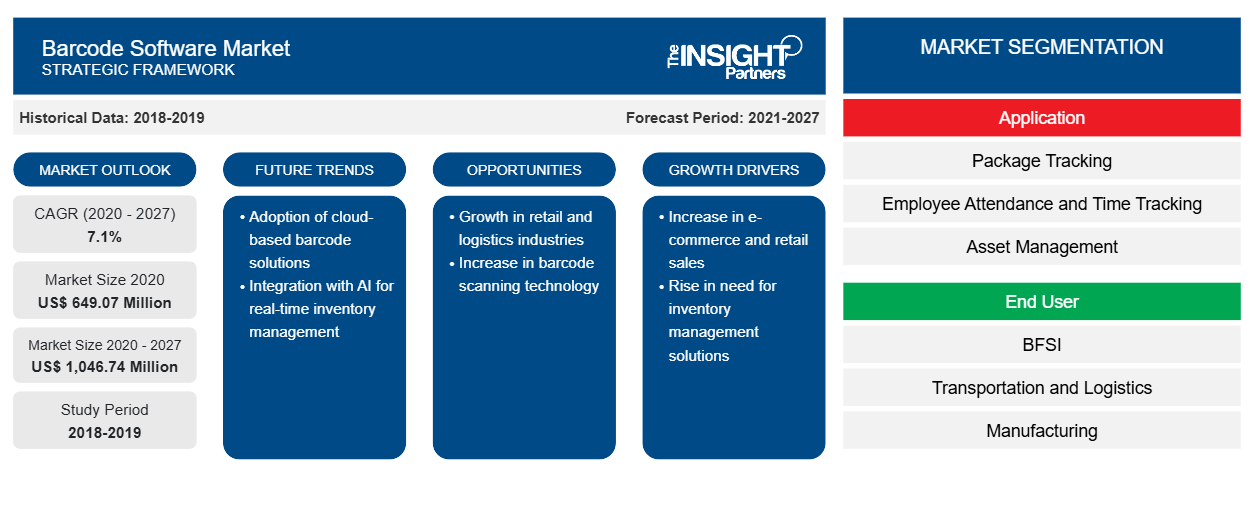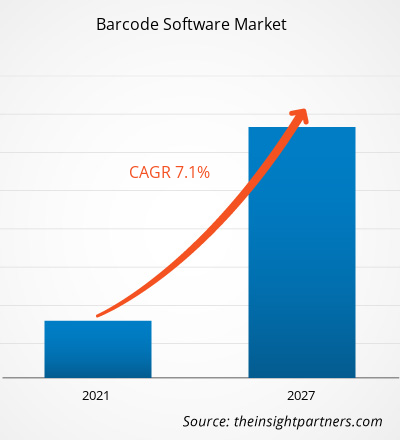2020 年条码软件市场价值为 6.4907 亿美元,预计 2020 年至 2027 年的复合年增长率为 7.1%。
供应链管理对条形码软件的需求是市场增长的原因。条形码技术改进和增强了供应链管理的各个方面。它使整个业务集成过程有效而顺畅。该技术有助于在极短的时间内跟踪产品装运状态,从而减少整个过程中的错误。此外,它价格合理且易于操作。由于这些好处,条形码技术在企业中的使用越来越普遍,尤其是在供应链管理中。通过条形码软件进行跟踪有助于节省时间和金钱,并确保使用准确的数据进行决策。手动库存管理需要几个小时才能完成;另一方面,条形码标记可以实时跟踪和分析货物,使整个供应链操作顺畅而快速。第戎大学医院实施了 GS1 条形码,以确保更高的供应链安全性和效率。此外,这些条形码帮助医院更顺畅、更高效地运营,同时完全减少了错误。同样,Zebra Technologies Corporation 在其一份报告中引用了一家烘焙公司的案例,该公司在实施库存跟踪系统后的第一年就将库存和配送成本降低了 300 万美元。监控和获取有关其产品的更多信息使这家烘焙公司能够获得准确、及时的库存信息。因此,条形码技术的优势使其成为节省时间和减少错误的流行方法之一,这正在不断增加企业对条形码技术的需求,从而为解决方案供应商创造了机会,以针对供应链环节进行扩展和创收。
定制此报告以满足您的需求
您可以免费定制任何报告,包括本报告的部分内容、国家级分析、Excel 数据包,以及为初创企业和大学提供优惠和折扣
- 获取此报告的关键市场趋势。这个免费样品将包括数据分析,从市场趋势到估计和预测。
COVID-19 疫情对条码软件市场的影响
由于封锁、旅行禁令和企业停业,冠状病毒疫情已影响到各国的经济和行业。由于大多数国家都实行封锁,对条码软件的需求正在显著下降。这是因为,主要的条码软件购买国一直在限制对这些组件的投资,并利用相当一部分预算来对抗 COVID-19。制造工厂的暂时关闭也显示出条码软件市场的负面趋势。COVID-19 的持续蔓延对条码软件市场参与者来说将非常危险。
市场洞察–条码软件市场
需要准确的实时数据收集流程
条形码软件解决方案提高了数据收集的速度和准确性,从而使各种规模的公司都能加快业务运营。这些软件产品减少了人为错误并改善了库存管理流程。随着医疗保健、制造业、零售业和运输业等企业之间的竞争日益激烈,对准确的数据实时收集技术的需求也显著增加,这催生了对先进且易于实施的条形码软件解决方案的需求。TEKLYNX 提供标签设计解决方案,可帮助创建带有文本、图像和条形码的简单标签以及符合不同法规的更复杂的标签。TEKLYNX 条形码软件的一些主要功能包括设计和集成功能、全面的数据库连接和行业领先的标签模板。同样,Denso ADC、General Data Company、Honeywell International 和 Zebra Technologies Corporation 也为各种行业的需求和要求提供了有效且高效的条形码软件解决方案。制造商使用条形码软件来跟踪库存数量,同时降低运营风险并消除业务运作中不必要的延迟。许多小型、中型和大型制造公司正在寻求更高效、更实惠的条码软件解决方案,这推动了整个市场的发展。
基于应用的洞察
根据应用,条码软件市场分为包裹跟踪、员工考勤和时间跟踪、资产管理等。资产管理部门在 2019 年占据了最大的市场份额。
条码软件市场的参与者主要致力于开发先进、高效的产品。
- 2020 年,通用数据公司宣布收购 AmeriGraph Packaging Group(佐治亚州亚特兰大)。此次收购扩大了通用数据的标签加工能力,包括消费品和食品的优质标签和收缩套包装,并增加了东南配送中心,以更好地服务现有客户。
- 2020 年,自动数据采集和过程自动化市场的全球领导者 Datalogic 很高兴地宣布推出 Matrix™320,这是一款功能最强大、最紧凑的工业固定式基于图像的代码阅读器,能够提供顶级性能、灵活性、操作员安全性和低总体拥有成本。
条码软件市场区域洞察
Insight Partners 的分析师已详细解释了预测期内影响条码软件市场的区域趋势和因素。本节还讨论了北美、欧洲、亚太地区、中东和非洲以及南美和中美洲的条码软件市场细分和地理位置。

- 获取条码软件市场的区域特定数据
条码软件市场报告范围
| 报告属性 | 细节 |
|---|---|
| 2020 年市场规模 | 6.4907亿美元 |
| 2027 年市场规模 | 10.4674亿美元 |
| 全球复合年增长率(2020 - 2027 年) | 7.1% |
| 史料 | 2018-2019 |
| 预测期 | 2021-2027 |
| 涵盖的领域 | 按应用
|
| 覆盖地区和国家 | 北美
|
| 市场领导者和主要公司简介 |
|
条码软件市场参与者密度:了解其对业务动态的影响
条码软件市场正在快速增长,这得益于最终用户需求的不断增长,而这些需求又源于消费者偏好的不断变化、技术进步以及对产品优势的认识不断提高等因素。随着需求的增加,企业正在扩大其产品范围,进行创新以满足消费者的需求,并利用新兴趋势,从而进一步推动市场增长。
市场参与者密度是指在特定市场或行业内运营的企业或公司的分布情况。它表明在给定市场空间中,相对于其规模或总市场价值,有多少竞争对手(市场参与者)存在。
在条码软件市场运营的主要公司有:
- 蓝鸟公司
- 数据逻辑公司
- 霍尼韦尔国际公司
- NCR 公司
- 斑马技术公司
免责声明:上面列出的公司没有按照任何特定顺序排列。

- 获取条形码软件市场顶级关键参与者概览
条码软件市场细分如下:
全球条码软件市场 - 按应用
- 包裹追踪
- 员工考勤和时间追踪
- 资产管理
- 其他的
全球条码软件市场 - 按最终用户
- 金融保险业协会
- 运输和物流
- 制造业
- 卫生保健
- 零售
- 其他的
条码软件市场 – 按地区划分
北美
- 我们
- 加拿大
- 墨西哥
欧洲
- 法国
- 德国
- 意大利
- 俄罗斯
- 英国
- 欧洲其他地区
亚太地区 (APAC)
- 日本
- 中国
- 澳大利亚
- 印度
- 韩国
- 亚太地区其他地区
中东和非洲 (MEA)
- 沙特阿拉伯
- 阿联酋
- 南非
- MEA 其他地区
南美洲 (SAM)
- 巴西
- 阿根廷
- SAM 其余部分
条码软件市场 – 公司简介
- 蓝鸟公司
- 动态系统公司
- CVISION 技术公司
- 数据逻辑公司
- 电装模拟/数字转换器
- 通用数据公司
- 霍尼韦尔国际公司
- NCR 公司
- 斑马技术公司
- 泽比克斯工业公司
- 历史分析(2 年)、基准年、预测(7 年)及复合年增长率
- PEST 和 SWOT 分析
- 市场规模价值/数量 - 全球、区域、国家
- 行业和竞争格局
- Excel 数据集



Report Coverage
Revenue forecast, Company Analysis, Industry landscape, Growth factors, and Trends

Segment Covered
This text is related
to segments covered.

Regional Scope
North America, Europe, Asia Pacific, Middle East & Africa, South & Central America

Country Scope
This text is related
to country scope.
常见问题
Based on application, the asset tracking segment is dominated the market in 2019. Enterprises across the industry vertical, use barcode technology to track and manage company asset in real-time. Data capture software offered by solution providers has transformed camera equipped devices into a powerful barcode scanner; thereby, helping organizations to effectively mobilize their asset management via various tracking apps.
Need for accurate real time data collection method along with increasing demand for such software among logistics & transportation and healthcare sector is driving the global barcode software market.
In terms of revenue share, Asia Pacific held the largest share of global Barcode Software market in 2019 and it is anticipated to continue its dominance over the forecast period of 2020 to 2027. North America is the second largest revenue contributor, followed by Europe in 2019. Strong industry base especially in BFSI, IT & telecom, automotive, healthcare, and retail sectors is the major factors responsible for high adoption of Barcode Software solutions in the Asia Pacific region.
Trends and growth analysis reports related to Technology, Media and Telecommunications : READ MORE..
The List of Companies - Barcode Software Market
- Bluebird Inc.
- Datalogic S.P.A.
- Honeywell International, Inc.
- NCR Corporation
- Zebra Technologies Corporation
- Dynamic Systems Inc.
- CVISION Technologies
- DENSO ADC
- General Data Company
- Zebex Industries Inc.
The Insight Partners performs research in 4 major stages: Data Collection & Secondary Research, Primary Research, Data Analysis and Data Triangulation & Final Review.
- Data Collection and Secondary Research:
As a market research and consulting firm operating from a decade, we have published and advised several client across the globe. First step for any study will start with an assessment of currently available data and insights from existing reports. Further, historical and current market information is collected from Investor Presentations, Annual Reports, SEC Filings, etc., and other information related to company’s performance and market positioning are gathered from Paid Databases (Factiva, Hoovers, and Reuters) and various other publications available in public domain.
Several associations trade associates, technical forums, institutes, societies and organization are accessed to gain technical as well as market related insights through their publications such as research papers, blogs and press releases related to the studies are referred to get cues about the market. Further, white papers, journals, magazines, and other news articles published in last 3 years are scrutinized and analyzed to understand the current market trends.
- Primary Research:
The primarily interview analysis comprise of data obtained from industry participants interview and answers to survey questions gathered by in-house primary team.
For primary research, interviews are conducted with industry experts/CEOs/Marketing Managers/VPs/Subject Matter Experts from both demand and supply side to get a 360-degree view of the market. The primary team conducts several interviews based on the complexity of the markets to understand the various market trends and dynamics which makes research more credible and precise.
A typical research interview fulfils the following functions:
- Provides first-hand information on the market size, market trends, growth trends, competitive landscape, and outlook
- Validates and strengthens in-house secondary research findings
- Develops the analysis team’s expertise and market understanding
Primary research involves email interactions and telephone interviews for each market, category, segment, and sub-segment across geographies. The participants who typically take part in such a process include, but are not limited to:
- Industry participants: VPs, business development managers, market intelligence managers and national sales managers
- Outside experts: Valuation experts, research analysts and key opinion leaders specializing in the electronics and semiconductor industry.
Below is the breakup of our primary respondents by company, designation, and region:

Once we receive the confirmation from primary research sources or primary respondents, we finalize the base year market estimation and forecast the data as per the macroeconomic and microeconomic factors assessed during data collection.
- Data Analysis:
Once data is validated through both secondary as well as primary respondents, we finalize the market estimations by hypothesis formulation and factor analysis at regional and country level.
- Macro-Economic Factor Analysis:
We analyse macroeconomic indicators such the gross domestic product (GDP), increase in the demand for goods and services across industries, technological advancement, regional economic growth, governmental policies, the influence of COVID-19, PEST analysis, and other aspects. This analysis aids in setting benchmarks for various nations/regions and approximating market splits. Additionally, the general trend of the aforementioned components aid in determining the market's development possibilities.
- Country Level Data:
Various factors that are especially aligned to the country are taken into account to determine the market size for a certain area and country, including the presence of vendors, such as headquarters and offices, the country's GDP, demand patterns, and industry growth. To comprehend the market dynamics for the nation, a number of growth variables, inhibitors, application areas, and current market trends are researched. The aforementioned elements aid in determining the country's overall market's growth potential.
- Company Profile:
The “Table of Contents” is formulated by listing and analyzing more than 25 - 30 companies operating in the market ecosystem across geographies. However, we profile only 10 companies as a standard practice in our syndicate reports. These 10 companies comprise leading, emerging, and regional players. Nonetheless, our analysis is not restricted to the 10 listed companies, we also analyze other companies present in the market to develop a holistic view and understand the prevailing trends. The “Company Profiles” section in the report covers key facts, business description, products & services, financial information, SWOT analysis, and key developments. The financial information presented is extracted from the annual reports and official documents of the publicly listed companies. Upon collecting the information for the sections of respective companies, we verify them via various primary sources and then compile the data in respective company profiles. The company level information helps us in deriving the base number as well as in forecasting the market size.
- Developing Base Number:
Aggregation of sales statistics (2020-2022) and macro-economic factor, and other secondary and primary research insights are utilized to arrive at base number and related market shares for 2022. The data gaps are identified in this step and relevant market data is analyzed, collected from paid primary interviews or databases. On finalizing the base year market size, forecasts are developed on the basis of macro-economic, industry and market growth factors and company level analysis.
- Data Triangulation and Final Review:
The market findings and base year market size calculations are validated from supply as well as demand side. Demand side validations are based on macro-economic factor analysis and benchmarks for respective regions and countries. In case of supply side validations, revenues of major companies are estimated (in case not available) based on industry benchmark, approximate number of employees, product portfolio, and primary interviews revenues are gathered. Further revenue from target product/service segment is assessed to avoid overshooting of market statistics. In case of heavy deviations between supply and demand side values, all thes steps are repeated to achieve synchronization.
We follow an iterative model, wherein we share our research findings with Subject Matter Experts (SME’s) and Key Opinion Leaders (KOLs) until consensus view of the market is not formulated – this model negates any drastic deviation in the opinions of experts. Only validated and universally acceptable research findings are quoted in our reports.
We have important check points that we use to validate our research findings – which we call – data triangulation, where we validate the information, we generate from secondary sources with primary interviews and then we re-validate with our internal data bases and Subject matter experts. This comprehensive model enables us to deliver high quality, reliable data in shortest possible time.


 获取此报告的免费样本
获取此报告的免费样本